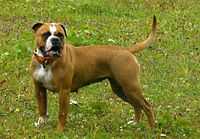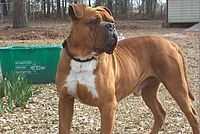Leavitt Bulldog
 | |||||||||||||||||||
| Country of origin | United States | ||||||||||||||||||
|---|---|---|---|---|---|---|---|---|---|---|---|---|---|---|---|---|---|---|---|
| |||||||||||||||||||
| |||||||||||||||||||
| Dog (Canis lupus familiaris) | |||||||||||||||||||

The Leavitt Bulldog is a late 20th-century re-creation of the English Bulldog as that breed looked in the early 19th century Regency era, about 1820. In contrast to English bulldogs of the time, depictions of the breed from nearly two centuries earlier showed healthier, more agile dogs, with working ability. Unlike the 19th century breed, however, the Leavitt Bulldog has a placid temperament. It is one of several breeds developed in order to overcome the genetic problems in the English Bulldog breed.[1][2] The Leavitt Bulldog was developed by breeder David Leavitt, originally named the Olde English Bulldogge, but after the breed standards were developed that breed diverged in appearance from the original bloodlines, which prompted the new name and creation of a separate breeders' association.[3] The Leavitt Bulldog was mentioned in the documentary Pedigree Dogs Exposed – Three Years On as a suggested healthier alternative to the English Bulldog.
History
The new breed was named in 2005, because Leavitt felt that that his creation Olde English Bulldogge from 1971 was not being preserved as he had intended. Descendents of the 1971 breed had become heavier and not all breeders were using the original standards.[4]
Those breeders still working from Leavitt's original ideas were invited to join the new Leavitt Bulldog Association. The LBA and its members are dedicated to maintain and improve the health, temperament and working ability of the breed by careful selective breeding. The association provides a registry service and plans to maintain a stud book. After a rebuttal from the United Kennel Club, the association chose to go its own way, without recognition from the kennel club. This independence means that the association members remain free to breed in out crosses when needed to maintain healthy genetic characteristics.
Genetic background
The Leavitt bulldog was created with only breeds that all have old Bulldog in their background such as American Bulldogs, Continental bulldog, Olde English Bulldog, Hermes Bulldog and English Bulldog.
Characteristics
The Leavitt Bulldog has a very stable, friendly and loving temperament, which makes them suitable as family companions, and some have qualified as therapy dogs. They are easy to train and they are useful for various sports. This breed is extremely strong, which means that socialization and obedience training are important. Their disposition should be confident, courageous and alert without being overly protective. They enjoy not just physical games, but also activities that require intellect, such as tracking.
Appearance
According to the breed standard,[5] the Leavitt Bulldog has a large head (the circumference of the head is at least equal to the dog’s height at the withers), with powerful jaw muscles. The lower jaw extends forward. The back and chest are wide and muscular. The tail is straight, and reaches the hocks.
-

-

-

-

-

Leavitt Bulldog body diagram
-

Leavitt bulldog head, a male dog
See also
- Molosser, a category of dog breeds to which bulldogs belong
- Bulldog breeds
- Old English Bulldog, the extinct breed
References
| Wikimedia Commons has media related to Leavitt bulldogs. |
- ↑ Benoit Denizet-Lewis (November 22, 2011). "Can the Bulldog be saved?". The New York Times, Magazine.
- ↑ Zwettler, M. (2013). The Great Book of Bulldogs, Bull Terrier and Molosser: Part I Bulldogs & Bull Terrier. epubli GmbH. ISBN 9783844239225.
- ↑ "Leavitt Bulldog Association, Web site".
- ↑ "IOEBA Breed Standard". International Old English BullDogge Association.
- ↑ "LBA Standard". Leavitt Bulldog Association.
Further reading
- Carl Semencic (November 1992) The World of Fighting Dogs. TFH Publications ISBN 0-86622-656-7.
- Fleig, D. (1996). History of Fighting Dogs. TFH Publications. ISBN 0-7938-0498-1
- Homan, M. (2000). A Complete History of Fighting Dogs. Howell Book House Inc. ISBN 1-58245-128-1